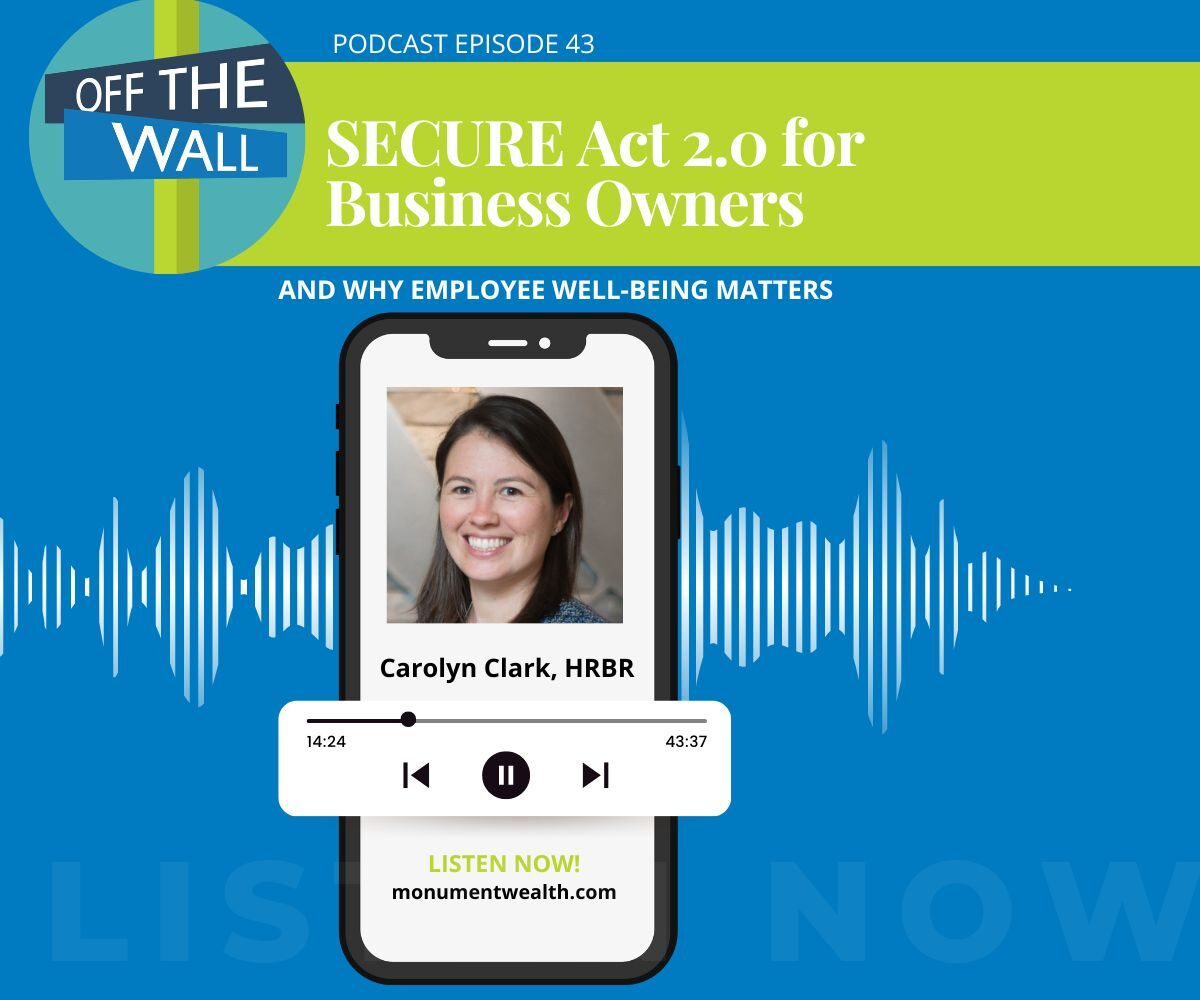Monument Wealth Management Articles
New with SECURE Act 2.0: Transfer Your 529 to a Roth IRA

Share on your favorite platform, or by email
Wealth and our goals for what that wealth can enable are deeply personal, but chances are they involve wanting to help our loved ones succeed and live healthy, happy lives in some form or fashion. For those with children, that often means providing enriching educational experiences and opportunities that will greatly shape their futures.
Congress recently passed SECURE 2.0 Act of 2022 (SECURE 2.0) which includes a noteworthy financial planning opportunity for those who want to tax-efficiently save for their children’s education using a 529 plan.
Here are the details!
Before SECURE 2.0:
Earnings from these tax-advantaged accounts could generally only be withdrawn tax and penalty-free for qualified education expenses or for student loan repayment of up to $10,000. Parents trying to navigate the uncertainty of where their children would attend college and the actual costs had to carefully consider how much to contribute to a 529 account to avoid overfunding.
After SECURE 2.0:
The new SECURE Act 2.0 provisions allow unused money from a 529 account to be rolled over into a tax-free Roth IRA for the same beneficiary. While this creates greater flexibility and enhances opportunities for long-term tax-free growth, there are some things to keep in mind when considering this new benefit.
Important Things to Note About Transferring a 529 to a Roth IRA
Uncle Sam Won’t Let You Have Too Much of a Good Thing
Congress wasn’t looking for a total departure from the spirit of 529 plans when enacting SECURE 2.0. They created strict limitations on unused 529 funds being transferred to Roth IRAs. The 529-to-Roth transfer provisions are effective as of 2024 and require that:
- The 529 account must have existed for at least 15 years.
- Contributions or earnings on contributions made within the last 5 years can NOT be transferred (i.e. in 2030, you can’t transfer any contributions or earnings made from 2025-2029).
- The transfers are subject to annual Roth IRA contribution limits. In addition, the beneficiary must have earned income equal to or greater than the amount being transferred to the Roth (i.e. if the Roth IRA contribution limit is $6,500 in 2024, you could transfer $6,500 in 2024 assuming the beneficiary had at least $7,000 in earned income).
- One notable allowance is transfers are allowed up to the Roth IRA contribution limit for a year even if the beneficiary’s income exceeds the upper limits for Roth contribution eligibility. This means that beneficiaries whose income is too high for Roth contributions may still transfer 529 funds into a Roth IRA.
- No more than $35,000 in total can be transferred from a 529 to a Roth IRA for a beneficiary over their lifetime.
Setting Children Up for Success (And Receiving Favorable Tax Treatment) Can Go Beyond Education
If you have more funds in a 529 than you need to pay qualified educational expenses, you can give your children a great head start on retirement savings by transferring funds from a 529 to a Roth IRA. $35,000 might not seem like a lot of money, but when you consider the power of compounding over the lifetime of a young person, that $35,000 could easily become a few hundred thousand dollars by age 65 with modest investment returns.
No matter the situation young adult children find themselves in, the SECURE Act 2.0 provisions can be beneficial.
Consider these opportunities:
- For some young adults beginning their careers, it can be difficult to juggle saving for long-term goals like retirement with other shorter-term goals like purchasing a home or starting families of their own. Having a Roth IRA “nest egg” can take some of the pressure off when it comes to trying to save for ALL of their priorities when they may not have the income to do so.
- For high earners, saving directly in a Roth IRA might not be an option if their income exceeds a certain amount. Having a head start with funds that will be tax-free in the future can allow them to optimally manage their taxes over their lifetime.
- While Roth IRAs are most powerful when allowed to compound over many years, contributions made to a Roth IRA can be withdrawn tax and penalty-free if needed. This can give young adults some flexibility in distributing funds if something unexpected comes up—although a Roth IRA should not be treated as an emergency fund!
- For parents or family members who have the means to contribute more to a 529 than a child might need solely for future educational expenses, the contributions can eventually be transferred to a Roth IRA. With careful planning, families can take advantage of the power of tax-efficient compounding to create a secure footing for financial wellness and happiness in the future, while also benefitting from tax deductions for contributions made to certain state 529 plans.
If you’ve been thinking about providing future opportunities for your loved ones but aren’t sure where to start, let’s have a conversation. We know that wealth comes with a lot of questions and uncertainty about the future. Monument’s team of experts can remove anxiety about the future by developing a clear, actionable, customized, and tax-efficient plan that will help you and your loved ones untap not only your potential for wealth, but your potential for living.

Don’t miss our episode “Secure Act 2.0 for Business Owners” with our guest from Capital One®
Ready for straightforward, unfiltered
opinion and tailored advice for YOUR questions, not everyone else’s?
IMPORTANT DISCLOSURE INFORMATION
Please remember that past performance is no guarantee of future results. Different types of investments involve varying degrees of risk, and there can be no assurance that the future performance of any specific investment, investment strategy, or product (including the investments and/or investment strategies recommended or undertaken by Monument Capital Management, LLC [“Monument”]), or any non-investment related content, made reference to directly or indirectly in this blog will be profitable, equal any corresponding indicated historical performance level(s), be suitable for your portfolio or individual situation, or prove successful. Due to various factors, including changing market conditions and/or applicable laws, the content may no longer be reflective of current opinions or positions. Moreover, you should not assume that any discussion or information contained in this blog serves as the receipt of, or as a substitute for, personalized investment advice from Monument. To the extent that a reader has any questions regarding the applicability of any specific issue discussed above to his/her individual situation, he/she is encouraged to consult with the professional advisor of his/her choosing. No amount of prior experience or success should be construed that a certain level of results or satisfaction will be achieved if Monument is engaged, or continues to be engaged, to provide investment advisory services. Monument is neither a law firm nor a certified public accounting firm and no portion of the blog content should be construed as legal or accounting advice.
A copy of Monument’s current written disclosure Brochure discussing our advisory services and fees is available for review upon request or at www.monumentwealthmanagement.com/disclosures. Please Note: Monument does not make any representations or warranties as to the accuracy, timeliness, suitability, completeness, or relevance of any information prepared by any unaffiliated third party, whether linked to Monument’s website or blog or incorporated herein, and takes no responsibility for any such content. All such information is provided solely for convenience purposes only and all users thereof should be guided accordingly.
Historical performance results for investment indices, benchmarks, and/or categories have been provided for general informational/comparison purposes only, and generally do not reflect the deduction of transaction and/or custodial charges, the deduction of an investment management fee, nor the impact of taxes, the incurrence of which would have the effect of decreasing historical performance results. It should not be assumed that your Monument account holdings correspond directly to any comparative indices or categories. Please Also Note: (1) performance results do not reflect the impact of taxes; (2) comparative benchmarks/indices may be more or less volatile than your Monument accounts; and, (3) a description of each comparative benchmark/index is available upon request.
Please Remember: If you are a Monument client, please contact Monument, in writing, if there are any changes in your personal/financial situation or investment objectives for the purpose of reviewing/evaluating/revising our previous recommendations and/or services, or if you would like to impose, add, or to modify any reasonable restrictions to our investment advisory services. Unless, and until, you notify us, in writing, to the contrary, we shall continue to provide services as we do currently. Please Also Remember to advise us if you have not been receiving account statements (at least quarterly) from the account custodian.
